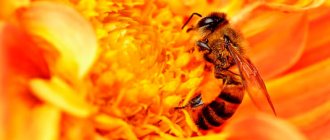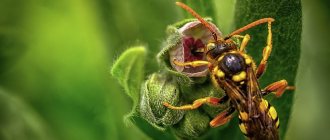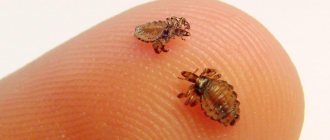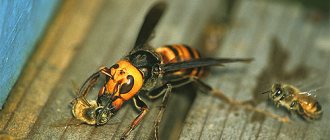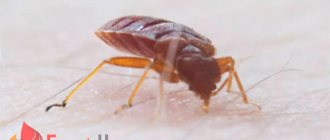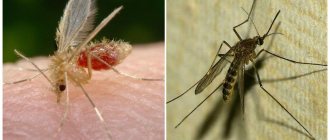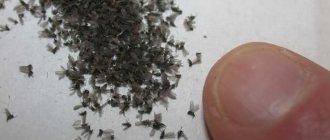In Japan and in the south of Sakhalin Island there lives a large and dangerous insect, the attack of which kills an average of 40 people every year - more than from the attacks of any other animals living in this corner of the Earth, including large predators. This is a Japanese huge hornet (Latin name - vespa mandarinia japonica).
In Japan, this hornet is called the “sparrow-bee”. It is slightly smaller in size than its close relative, the Asian giant hornet, but has a more toxic poison.
This insect reaches more than 4 cm in length, with a wingspan of over 6 cm. The organs of vision are also unusual in the structure of the insect’s body: in addition to two large standard eyes, the “sparrow-bee” has three small additional eyes.
A large head with powerful jaws and a yellow-black, wasp-like coloring add to its ferocious appearance. But the hornet’s main weapon is its sting, reaching 6.25 mm in length, with which the insect inflicts a very painful blow when attacking.
Why is the hornet of the genus Vespa mandarinia dangerous for humans?
Important! Japanese hornets use their stings for protection. In any case, this is what famous entomologists, scientists who study insects, say. They advise, if you see a hornet nest, to urgently leave this territory, because the insect will regard their appearance as a desire to harm the larvae, and then the person will be attacked
The local population and visitors who have become victims of the stings of these giant insects do not agree with entomologists. Hornets strike with their toxic poison even far from their nest due to their bad character. A meeting between a person and a Japanese hornet does not bode well, so you should not expect that the hornet, sitting on your body, will simply flutter up and fly away. It will sting, and this is not only very painful, but also life-threatening, because the poison that it injects has the following composition and properties:
They advise that if you see a hornet nest, you should urgently leave this area, because the insect will regard their appearance as a desire to harm the larvae, and then the person will be attacked. The local population and visitors who have become victims of the stings of these giant insects do not agree with entomologists. Hornets strike with their toxic poison even far from their nest due to their bad character. A meeting between a person and a Japanese hornet does not bode well, so you should not expect that the hornet, sitting on your body, will simply flutter up and fly away. It will sting, and this is not only very painful, but also life-threatening, because the poison that it injects has the following composition and properties:
In any case, this is what famous entomologists, scientists who study insects, say. They advise that if you see a hornet nest, you should urgently leave this area, because the insect will regard their appearance as a desire to harm the larvae, and then the person will be attacked. The local population and visitors who have become victims of the stings of these giant insects do not agree with entomologists. Hornets strike with their toxic poison even far from their nest due to their bad character. A meeting between a person and a Japanese hornet does not bode well, so you should not expect that the hornet, sitting on your body, will simply flutter up and fly away. It will sting, and this is not only very painful, but also life-threatening, because the poison that it injects has the following composition and properties:
- Mandrotoxin is a neuroparalytic toxin that causes unbearable pain that torments the stung person for a long time, so that no pain relief helps.
- Histamines and the protein contained in the venom of this giant cause a violent allergic reaction that can only be blocked by injections of adrenaline. But, if a person is prone to allergies, then anaphylactic shock from the sting of this insect occurs almost instantly, so the outcome can be fatal. Most people who die from the Japanese hornet are allergy sufferers who did not get help quickly enough.
- Tissues affected by poison disintegrate very quickly under the influence of the protein contained in the poison. This process is difficult to stop, and people recover from a hornet for a very long time, because tissue necrosis, extensive hemorrhages, and often damage to internal organs occur.
Important! There is a high chance of dying from a sting by a giant Japanese hornet for those people who were immediately attacked by a swarm of them. There is very little chance of escape here.
Features of the bite
The sting of Japanese hornets is very painful. It is compared to being hit with a hot nail. This species injects a highly toxic venom through its sting, which can be dangerous for allergy sufferers. Multiple bites, when members of the same family attack together, can result in death for any person. Children should be especially wary.
Toxicity of the poison to humans
Japanese hornets produce poison that has a nerve-paralytic effect. It contains mandorotoxin, a dangerous neurotoxin. Along with it, acetylcholine is injected, a substance that attracts other members of the nest. Usually, people who come close to the nest or kill the hornet are subject to multiple attacks.
Disturbed insects, after a signal calling for an attack, can pursue the offender for up to 5 km. Their venom can cause cardiac arrest and anaphylactic shock, which manifests itself within a short time. It destroys tissue and causes severe pain and can cause allergies.
First symptoms
After severe pain from a hornet sting, the following symptoms are observed:
- redness at the site of the bite;
- rapid and extensive inflammatory process;
- hardening of tissue at the site of injury;
- edema;
- headaches and dizziness;
- labored breathing;
- cardiopalmus;
- enlarged lymph nodes;
- elevated temperature.
If you are bitten by a Japanese hornet, medical attention should be provided immediately. Otherwise, destruction of tissue at the site of the bite can damage nearby organs and cause bleeding in them.
What to do if you are bitten
Hornets rarely attack humans, but if it was not possible to avoid their attacks, then the following measures should be taken as quickly as possible:
- Apply cold to the bite site.
- Wipe the bite area with hydrogen peroxide or magenta.
- Make a compress from saline solution or sprinkle crushed aspirin on the bite area. You can add a cut of a cucumber, plantain or onion.
- Be sure to take the antihistamine you have in stock, “Suprastin”, “Claritin”. For an allergy sufferer, it is better to immediately inject an antiallergic drug - Diphenhydramine, Suprastin, Dexamethasone.
- If the bite is on your hand, you should immediately remove the rings and bracelets - if swelling appears, this will be difficult to do.
Particular vigilance should be exercised if the sting gets into the head or neck area. In this case, in addition to the above measures, it is better to immediately call an ambulance.
Important! Do not scratch the bite site or treat with alcohol-containing preparations. It is not allowed to take sleeping pills or alcohol to relieve pain
Allergy
The victim should be treated with antihistamines or glucocorticoids.
These include:
- Hydrocortisone;
- Diphenhydramine;
- Prednisolone.
- Suprastin;
- Dexamethasone;
- Loratadine;
Timely intake of the above medications eliminates the risk of severe symptoms and allergic reactions.
It is important to remember that these drugs have side effects, so it is recommended to take them only when necessary so as not to worsen the patient's condition.
If there is no allergic reaction, pain can be alleviated with the help of special ointments and lotions, among which Soventol and Fenistil gel show good effectiveness.
A disaster for humans or an adornment of nature?
In a global sense, giant Asian hornets are, of course, dangerous to people, but this danger is not critical, since it is entirely provoked by man himself. These insects are not very aggressive by nature; they will only attack in self-defense or protecting a nest.
Photo 14.
Hornets cause much more damage to apiaries, especially those where less aggressive European honey bees are bred. Sometimes hornets manage to destroy an entire bee family in a few hours, and therefore local beekeepers wage an ongoing systematic fight against them.
In general, the mortality rate from giant hornet bites is quite high: in some regions, up to 100 people die per year. But in fairness, it should be said that most of the dead are the same beekeepers who, without special means of protection, actively destroy hornet nests and, as a result, fall under their massive attacks.
A simple tourist who accidentally finds himself in the forest next to the Vespa Mandarinia hornet should not be afraid of this insect - it will not attack without a reason.
Photo 15.
In the West, many dietary supplements add synthetic substances similar to the secretion contained in developing hornet larvae. These components are believed to increase human endurance. However, there is no experimental evidence for these claims.
In conclusion, it should be noted that for wildlife, giant hornets are one of the most active natural orderlies. They successfully destroy many forest and agricultural pests, therefore, in most biocenoses - including agricultural lands - they are useful and deserve protection.
Photo 16.
Photo 17.
Photo 18.
Photo 19.
Photo 20.
Several dozen hornets completely destroyed a bee hive
The Asian giant hornet is the largest hornet in the world. If it sits on the hand, then its wings completely cover the palm, and the distance from the head to the end of the abdomen is quite consistent with the length of the little finger of an adult. It is not surprising that in Japan this wasp is called the “sparrow bee”: during the flight, the insect is very reminiscent of a small bird.
We can say with confidence that there is a connection between the size of this giant’s body and the severity of the consequences of meeting it: how big the largest hornet is, just as dangerous it is. Even a person who is not hypersensitive to insect venom may well die from its bites. Therefore, entomologists rightfully consider the giant hornet one of the most dangerous insects in the world.
According to statistics, in Japan alone, 40 to 50 people die annually as a result of giant hornet bites. Similar data are provided for individual districts of China where relevant records are kept. In Japan, even sharks are not responsible for the death of so many people.
Among other things, the huge hornet is a real scourge of many beekeeping farms
You have to fight it with extreme caution because of the serious danger of being stung
The relationship between the big hornet and humans has never been simple, and increased interest in it is often caused by a simple desire to tickle one’s nerves. Well, let's tickle...
Storm of all bees
The huge hornet causes the most trouble to Japanese beekeepers. Honey bees (usually the European variety, which are more industrious and less aggressive) are a real delicacy for hornets. However, the prey is not only bees, but also the honey they produce, which the giant predator feasts on after the destruction of the hive.
If a scout hornet finds a residential hive with bees, it leaves odorous marks near it, and upon returning to the nest, it shows its fellows the way to the delicacy. After this, the murder hornets set off as a whole squad to destroy the hive.
In fairness, it is worth noting that some species of bees, in turn, also have a unique mechanism for combating hornets. However, it gives results only with a small number of attackers. If the hornets attack in significant numbers, the bees, alas, are powerless.
So, how does the bees' defense mechanism work? The defense of the hive consists of several stages:
- at the very beginning, when the giant hornet tries to enter the hive, several bees surround it;
- then others sit on them, and this continues until a huge ball of bees, up to 30-35 cm in diameter, grows around the hornet;
- parallel to this process, all the defenders of the hive actively move their wings, directing the air inside the ball - towards the aggressor - and heating it to 46-47 ° C, which is destructive for the hornet (the bees themselves can withstand heating up to 50 ° C).
The result of all these efforts is the death of the attacking predator from overheating within about one hour.
Despite this seemingly effective mechanism, bees are not able to cope with an entire squad of winged killers. That is why the Japanese huge hornet is considered to be the cause of serious losses for beekeeping farms in this country. Owners and workers of apiaries are doing their best to destroy hornet nests near the locations of honey beehives.
However, the struggle of beekeepers against an enemy insect often ends in loss: a huge hornet, due to its size, can fly away in search of food up to 10 km from its nest, and pursue the victim itself up to 5 km. Therefore, despite all human efforts, destroying the nests of a giant predator often does not produce significant results in protecting apiaries.
Lifestyle
Life cycle
The development cycle of the Japanese hornet begins in May. At this time, the queen emerges from hibernation and builds a hive, often reaching gigantic proportions. When the home is ready, she lays eggs in honeycombs, the number of which ranges from 400 to 600 pieces. The larvae take 5 to 9 days to develop, and after another two weeks they turn into adult workers.
With the beginning of winter, the hornets die from the cold. Fertilized females hibernate, and the next year they become queens and continue the race again.
appearance of a Japanese hornet's nest
Nutrition
The daily diet of the Japanese hornet includes small insects, as well as fruits, berries and even meat. The larvae feed only on animal food.
Japanese giant hornet loves fruit
Building a nest
To build a nest, hornets use rotten wood, which they chew to mix with saliva. It is built for one year and is not reused. The queen selects a place to build a new nest.
A giant hornet's nest is being built in a tree
Reproduction
When the nest is built, the queen places one egg in each cell of the honeycomb. It takes 3-4 days for the larva to form. After 14 days, it turns into a pupa, then after another 15-21 days it becomes an adult and gnaws through the walls of the cell to get out.
Japanese hornet larvae make their way out
Wintering
The lifespan of a hornet is relatively short (from a month to three), and its life cycle mainly occurs in the warm season. Only queens are adapted to wintering. They hide in tree bark, under stones, in cracks in rocky areas, under roofs and in tree hollows. After wintering, the female looks for a new family, and the cycle repeats again.
Hornets against other insects
Against the bees
Hornets are several times larger in size than bees, making them ideal prey. Firstly, bees are easy to catch, and secondly, destroying the hive allows you to get to the honey. The killer insect is capable of destroying 30-40 bees within a minute. It takes only a few hours for a small group to completely destroy a full-fledged bee colony.
Against mantises
Their other frequent prey is praying mantises. They are quite vulnerable to strong predators, since they are practically not protected by chitinous cover. After a hornet catches a praying mantis, it most often gnaws off its front grasping legs in order to reduce resistance and deprive the victim of the opportunity to escape.
Hornet and praying mantis are old enemies
Against Scorpios
These giant insects often attack even small scorpions. During the battle, they exhaust their prey, and when it becomes weak, they pierce it with their sting.
Against stag beetles
One of the few insects that can defeat a hornet is the stag beetle. It is completely protected by chitinous armor, which protects against bites, and its highly developed upper jaws make it possible to break through the hornet’s defense and bite it.
Among hornets, a special place is occupied by the world's largest representative of this genus - Vespa Mandarinia, or the Asian giant hornet, a photo of which can be seen this year
As the name suggests, it is very difficult not to notice it, since this insect with a brightly colored body measuring up to 5 cm and an even more impressive wingspan of up to 7 cm cannot fail to attract attention. The Asian hornet is extremely dangerous and poisonous
Being able to distinguish it from its more harmless relatives is especially important for those who like to travel to exotic countries of mysterious and unique Asia. Interestingly, Vespa mandarin is one of the representatives of 23 species of hornets, which include common relatives living in Europe
The size of an insect is an anatomical adaptation to the climate in which it lives. Large insects can tolerate high temperatures much easier because they have a larger surface area to transfer heat to the environment.
Interestingly, Vespa mandarin is one of the representatives of 23 species of hornets, which include common relatives living in Europe. The size of an insect is an anatomical adaptation to the climate in which it lives. Large insects have a much easier time withstanding high temperatures because they have a larger surface area to transfer heat to the environment.
Moreover, due to the size of this killer, he can easily count on many victims, including those of comparable size to himself. Otherwise, the insect is similar to its other relatives in appearance.
Methods for destroying nests
First of all, you need to inspect the area to identify a hornet's nest.
When searching for them, you should carefully examine:
- tree trunks and branches;
- attic and roof sections;
- various places under the canopies of buildings;
- abandoned buildings;
- window openings;
- the upper and lower parts of the balcony.
The hives of these insects have an oval shape with a tapered bottom and are gray or brownish in color.
Sizes may vary depending on the number of living insects. Any measures to combat these large wasps must be carried out in protective clothing.
The following methods are used to destroy nests:
- mechanical;
- traps;
- bait;
- insecticidal preparations.
Did you know? In Japan, an average of about 40 deaths from Japanese hornet bites are recorded annually.
When destroying nests mechanically, you can do the following:
- Burn the nest. For this purpose, they put a large plastic bag on it and set it on fire. In this case, everything needs to be done very quickly. For safety reasons, the bag can be pre-treated with an insecticidal preparation, then kept tied for a longer time so that most of the insects die, and then set on fire.
- Place the nest in a bucket of water. For this purpose, you need to select a bucket of sufficient size so that the nest fits there. A bucket of water is brought to the hornets’ housing from below so that it is completely submerged in water. The container with water should be kept for at least 10–15 minutes so that all insects drown. When choosing this method, you should take into account that a filled bucket weighs quite a lot, and holding it in a certain position is also not easy. To enhance the effect, you need to take hot water or add kerosene, bleach or vinegar.
- Treatment with foam from a fire extinguisher. The entire nest should be thoroughly flooded so that the insects freeze from exposure to carbon dioxide. After a while the nest is knocked down.
- Use of construction foam. The frozen mass will wall up the entire home and will not allow insects to escape.
Traps and baits are used if nests cannot be found or if it is difficult to destroy them. Traps can be purchased at a garden store, or you can make them yourself. For this purpose, you need to take a plastic bottle and cut off 1/3 from the top, and then place the cut part with the neck down.
Pour sweet bait (jam, syrup, juice) onto the bottom. The hornets enter the bottle by smell for sweets, but they can’t get out again. Holes are made in the top of the bottle, through which strings or wires are threaded, and then hung on trees. Periodically, the traps are cleaned and new bait is added.
Important! Before cleaning the traps, you need to make sure all the insects are dead to avoid getting bitten. To reduce risks, it is better to spray the trap with an aerosol and wait.
You can prepare bait yourself. To do this, place containers (usually saucers) with favorite sweets for insects around the area. Poison is added to such sweets (boric acid, chemicals “Karbofos”, “Aktara”). After eating such food, the hornets will carry poison into their home on the body and infect other insects.
Special aerosols against hornets (“Dr. Klaus Aerosol”, “Dichlorvos”) are used as insecticides. Processing should be carried out very quickly, trying to get inside the nest and then go to a safe place. It is better not to approach the nest for several days, since the missing hornets returning to their dead relatives will be very aggressive.
The treated hornets' home should be burned after several days.
[edit] Attack on bees
The Japanese huge hornet also attacks social insects - other hornets, bees. This hornet greatly harms Japanese beekeeping, as it attacks the hives of the European honey bee, which Japanese beekeepers breed in apiaries, since European bees collect more honey than Japanese bees.
When a scout hornet finds a beehive, it leaves marks near it. Then the “scout” informs the other hornets about the find, and within a short time a large number of hornets flock to the hive and attack the bees.
Within three hours, Japanese hornets can destroy an entire hive - 30 thousand bees. They then dismember the bee brood, which they feed to their larvae. Hornets also eat honey from bees' honeycombs.
The Japanese honey bee uses a special tactic to protect itself from hornets: when a scout hornet flies up to their hive, a ball of about 500 bees immediately forms around the hornet. They surround the hornet in a huge ball, inside which the temperature can rise to 47 °C. Since bees are able to maintain and withstand temperatures up to 50 °C, the hornet dies.
Colony cycle
Nesting cycle of V. mandarinia
quite compatible with those of other eusocial insects. There are six phases to each cycle:
Pre-breeding period
There are two different types of queens that go into hibernation after a cycle: Inseminated queens and uninseminated queens. They will first emerge in early to mid-April and begin feeding on the sap of Quercus
.
Although this timing is consistent among Vespa
,
V. mandarinia
dominates the order, receiving preference for premium juice sources.
among V. mandarinia
queens. The queens at the top of the rankings will begin to feed while the other queens form a circle around her. Once the top queen finishes, the second highest queen will feed on the juice. This process will repeat itself until the last queen eats in her hour of need.
Solitary, joint and polyethic periods
The mated queens will begin looking for nesting sites in late April. Unbred queens will not seek out nests as their ovaries never fully develop. They will continue to feed but then disappear in early July.
The inseminated queen will begin to create relatively small cells in which she raises approximately 40 small workers. It is only at the beginning of July that workers begin to work outside the hive. Queens engage in activities outside the hive until mid-July, where they remain in the nest and allow the workers to do extradinal activities. In early August marks a fully developed nest, containing 3 combs holding 500 cells and 100 workers. From mid-September no more eggs are laid and the focus changes to caring for the larvae. The queens will die sometime between October 19th and October 31st.
Dissolution and wintering period
The men and new queens will take up their duties in mid-September and mid-October, respectively. At this time, their flesh color becomes intense and the queen's weight increases by approximately 20%. New males leave the nest in early October, while queens leave in early November. Once the males or queen leaves the nest, they do not return. In V. mandarinia
the males will wait outside the nest entrance until the queen appears. Once the queen emerges, they will attack her mid-air, bring her to the ground and copulate from 8 to 45 seconds. After this episode, the men will return to the entrance for a second chance while the queen leaves. I wonder how many queens will try to fight off men and unfertilized leave. After this episode, queens are found in damp, underground habitats.
When sexed people emerge, workers will shift their focus from protein and animal products to carbohydrates. The last sexed people to appear will die of starvation.
The largest bumblebee in the world
Bumblebees are part of the bee genus and are one of the closest species to ordinary honey bees. The largest are the Asian ones, which are often called killer bumblebees or tiger bees due to their tiger-like coloring.
These insects are usually quite large in size:
- the body is about 30 mm long in females and 26 mm in males;
- the width is about 15 mm;
- The wingspan can reach 50 mm in the largest individuals.
Note! Giant killer bumblebees most often live in forests, groves and agricultural lands, since in this area it is more convenient for them to build nests, which are usually located in the crowns of trees. Bumblebees are dangerous, and their poison is quite strong. After being stung, a person can easily end up in the hospital
After being stung, a person can easily end up in the hospital.
Giant bumblebee, or tiger bumblebee, is a name most often found in Japan or China. Despite the development of medicine and the creation of new drugs, a relatively large number of people still die from attacks by representatives of this species, numbering in the hundreds all over the world. The bumblebee is a more aggressive insect, and there are cases when it attacked first. It has well-developed jaws, so it can not only sting, but also bite painfully. Bites, by the way, hurt the most. However, for residents of Russia and other CIS countries there is no reason to fear, since this class does not occur here. You should only be careful if you are planning a trip to Asian countries.
Giant killer bumblebees most often live in forests, groves and farmland
Important! The giant bumblebee has a relatively small wingspan, making it appear that this insect is unable to fly normally. This disadvantage is compensated by more frequent strokes, sometimes the frequency can reach more than 400 per second, which is almost impossible to notice with the naked eye. This class of insects feeds on the sap of trees and plants, as well as the nectar of flowers.
The sting remains with the bumblebee after the attack, and therefore it has the ability to use it repeatedly. During the attack, he injects a small amount of poison. Particularly dangerous can be cases where it gets into a vein or vessel. Then the poison acts on the body faster. This manifests itself as more severe pain and swelling. An affected person with an allergy needs immediate medical attention
This class of insects feeds on the sap of trees and plants, as well as the nectar of flowers. The sting remains with the bumblebee after the attack, and therefore it has the ability to use it repeatedly. During the attack, he injects a small amount of poison. Particularly dangerous can be cases where it gets into a vein or vessel. Then the poison acts on the body faster. This manifests itself as more severe pain and swelling. An affected person with an allergy needs immediate medical attention.
Giant bumblebees and hornets are insects of enormous size for their species. They are poisonous and can cause severe harm. Despite this, they rarely attack on their own, most often in order to protect their habitat. This is worth considering when planning a trip to Asian countries. In Russia they are rare, but still, whoever is warned is protected!
What not to do
When providing first aid to someone who has been stung, you must also know what you should never do:
- Drink alcohol. Alcohol will further increase the swelling of soft, damaged skin tissue.
- It is forbidden to take Diprazine. It triggers the body's own immune response to a hornet sting.
- You cannot ignore a hornet bite, much less hope that nothing happens.
If a giant bites someone close to you, first aid must be provided.
If you behave tactlessly towards these insects, you should be prepared for unpleasant consequences. It is worth remembering that a hornet will never attack a person unless a threat comes from him. And some people get along with these people for years. In response, they protect the crop from various garden pests. But just in case, you should always have first aid supplies on hand.
Aggressive disposition
Another negative feature is the aggressiveness of the hornet. In search of food, these creatures without a shadow of a doubt attack other insects, and sometimes even animals. Moreover, sensing danger, they immediately attack their offender for an hour. At the same time, they are not at all embarrassed by the fact that their enemy can surpass them both in size and in numbers.
It is because of its aggressive nature that the Japanese hornet has become a threat to these islands. Everyone tries to avoid him. After all, who knows what mood the “sparrow bee” is in today - will she want to “greet” her guests?
As the name suggests, this insect lives on the Japanese islands and prefers rural areas, where it has the opportunity to find a suitable tree to create a nest. In Japan, these hornets are known as Wu-Suzumebachi (オオスズメバチ (大雀蜂, 大胡蜂), which translates to "Giant Sparrow Bee".
The Japanese giant hornet (vespa mandarinia japonica) is a subspecies of the Asian giant hornet. This is a large insect, the adult of which can exceed 4 cm in length and have a wingspan of more than 6 cm. The hornet has a large yellow head with huge eyes, a dark brown thorax, and brown and yellow stripes on the abdomen. The Japanese giant hornet has three small, simple eyes on the top of its head between two large compound eyes.
The diet of giant hornets consists of a wide range of insects, including crop pests, for this reason the hornets are considered beneficial. Working insects dismember the bodies of their victims to obtain only the most nutrient-rich body parts and take them to the nest. There, the hornets process their prey into a special paste to feed the larvae, which in turn produce the liquid so necessary for the working hornets. This liquid, known as Vespa, consists of a mixture of amino acids, is intended only for adult insects and is a remarkable means by which they can travel up to 100 kilometers per day and reach speeds of up to 40 kilometers per hour. This liquid provides the hornets with intense activity of the flight muscles for a long period, and research is currently underway to create stimulant drugs based on it to artificially increase athletic performance. In many Japanese mountain villages, fried hornets are considered a great delicacy.
Japanese beekeepers prefer European bees because they are more productive than the endemic Japanese bees. But keeping them has become quite problematic due to the fact that European bees are a favorite delicacy of Japanese giant hornets.
After the hornet has settled in a hive of European bees, it marks it with special pheromones, which attract its comrades to it; thanks to such markers, the brethren quickly find the hive. One hornet can kill forty European bees in a minute, and to deal with an entire hive containing 30,000 bees, a company of 30 hornets will need just over three hours. Hornets kill bees, dismember them, leaving their heads and limbs, and return to their nests with bee “fillets” which they feed to their larvae
Japanese endemic bees have evolved to defend themselves against giant hornet attacks. When the hornet approaches the hive to release pheromones, the worker bees fly out, form a swarm of 500 individuals, and surround the hornet, forming a tight ball around it. From the vibrating wings, the temperature inside this ball begins to rise to 47° C, creating the effect of a convection oven. The heat generated by the bees' organs spreads to the hornet, and since the bees can survive at higher temperatures (48 to 50 °C) than the hornet (44 to 46 °C), the latter dies.
Hornets are the largest representatives of the genus of social wasps. They are distributed throughout the Northern Hemisphere. The largest representative of this species is the Japanese hornet (Vespa Mandarinia), which, as the name suggests, lives in Japan and Asia. It is dangerous to humans, and bites can lead to death, but an attack occurs only if its life is threatened.
Appearance of the Japanese giant hornet
Lifestyle and nutrition
Each individual has its own responsibilities. Thus, the uterus is entrusted with the function of procreation; hard-working hornets are engaged in delivering food for it and the larvae. They feed on honey bees, agricultural pests, sugar-containing vegetables, and fruits. If a Japanese hornet discovers a hive of bees, it marks it with an odorous liquid so that it can later return here with its brothers. During the attack, they literally dismember their prey. Having dealt with large bees, the giants take honey and larvae for further food.
Interesting: in 90 minutes, 30 hornets can destroy an entire bee family. The giant will need no more than 60 seconds to destroy up to 40 bees.
Japanese poisonous hornet
Let's start with the fact that there is indeed a very dangerous toxin in the body of this insect. It is he who poses the greatest danger to others. Even a small amount of this poison, once under the skin, causes a terrible burning sensation and swelling. In this case, the toxin can be fatal to both animals and people.
You should understand a very obvious fact: since this is a giant hornet, there is also a lot of poison in it. Consequently, having stung a person, it can inject a horse dose of a deadly substance into his blood, which will inevitably cause an allergic reaction. And in some cases, such “bites” can even lead to anaphylactic shock or even death.
Habitat
The homeland of this insect is Japan. Beyond its borders, the Japanese hornet lives exclusively in the southern part of Sakhalin Island. In Eurasia, its closest brother is the Asian hornet. On the territory of the Russian Federation, its habitat is the Primorsky Territory. This is where it is found most often.
The hornet's cocoon is very similar to a wasp's nest; it is distinguished from the latter by its exceptionally large size. If a person himself does not bother them, they will not attack him. They attack if they are in great danger. To get rid of nests, you should use the services of certified specialists. Otherwise, there is a high probability of being stung.
